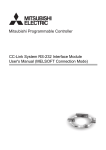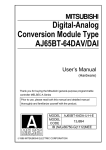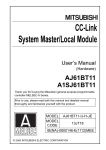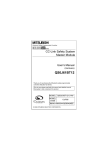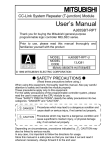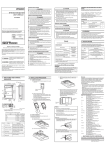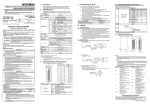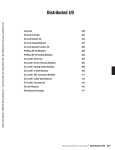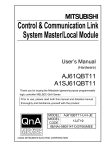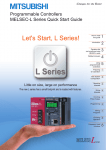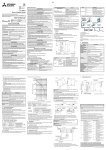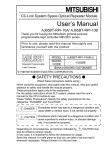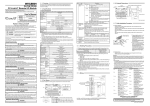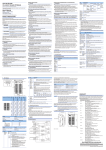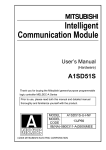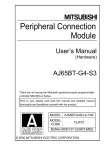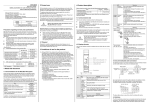Download CC-Link System RS-232 Interface Module User`s Manual (Hardware)
Transcript
CC-Link System RS-232
Interface Module
User’s Manual
(Hardware)
AJ65BT-R2N
Thank you for purchasing the Mitsubishi programmable controller
MELSEC-A series.
Prior to use, please read this and relevant manuals thorougly to fully
understand the product.
MODEL AJ65BT-R2N-U-HW
MODEL
13JY30
CODE
IB(NA)-0800381-D(1112)MEE
© 2007 MITSUBISHI ELECTRIC CORPORATION
SAFETY PRECAUTIONS
(Always read these instructions before using this equipment.)
Before using this product, please read this manual and the relevant manuals
introduced in this manual carefully and pay full attention to safety to handle the
product correctly.
The instructions given in this manual are concerned with this product. For the
safety instructions of the programmable controller system, please read the user's
manual for the CPU module used.
In this manual, the safety instructions are ranked as "
WARNING" and
"
CAUTION".
WARNING
Indicates that incorrect handling may cause
hazardous conditions, resulting in death or severe
injury.
CAUTION
Indicates that incorrect handling may cause
hazardous conditions, resulting in minor or moderate
injury or property damage.
Note that the
CAUTION level may lead to a serious consequence according
to the circumstances.
Always follow the instructions of both levels because they are important to
personal safety.
Please save this manual to make it accessible when required and always forward
it to the end user.
A-1
[Design Precautions]
WARNING
When controlling a running programmable controller (data modification) by
connecting a peripheral to a CPU module or connecting a personal computer
to an intelligent/special function module, create an interlock circuit on the
sequence program so that the whole system will operate safely all the time.
Also, before performing other controls (e.g. program modification, operating
status change (status control)), read this manual carefully and ensure the
safety.
Especially, in the control from an external device to a programmable
controller in a remote location, some programmable-controller-side problems
cannot be resolved immediately due to a data communication failure.
To prevent this, establish corrective procedures for communication failure
between the external device and the programmable controller CPU, as well
as creating an interlock circuit on the sequence program.
In the case of a data link error, the operation status of a faulty station is as
shown below. Using the communication status information, create an
interlock circuit on the sequence program for the system to operate safely.
Incorrect output or malfunction can lead to an accident.
(1) All of general-purpose inputs from this module turn OFF.
(2) All of general-purpose outputs from this module turn OFF.
Depending on the module failure, inputs and outputs may turn ON or OFF
incorrectly.
For I/O signals that may cause a serious accident, provide an external
monitoring circuit.
CAUTION
Do not bunch the control wires or communication cables with the main circuit
or power wires, or install them close to each other.
They should be installed 100 mm (3.94 inch) or more from each other.
Not doing so could result in noise that would cause erroneous operation.
Always use the data link terminal block for connection of a CC-Link dedicated
cable to a master module.
Care must be taken because, if the cable is incorrectly inserted into the
general-purpose I/O terminal block instead of the data link terminal block, the
module will break down.
A-2
[Installation Precautions]
CAUTION
Use the programmable controller in an environment that meets the general
specifications given in this manual.
Using this programmable controller in an environment outside the range of
the general specifications could result in electric shock, fire, erroneous
operation, and damage to or deterioration of the product.
Using a tool specified by the manufacturer, correctly press, crimp, or solder
the wires of the connector and securely connect the connector to the module.
Incomplete connection may cause a short circuit and/or malfunctions.
Do not directly touch the module's conductive parts or electronic
components.
Touching the conductive parts could cause an operation failure or give
damage to the module.
Securely fix the module with the DIN rail or installation screws. Installation
screws must be tightened within the specified torque range.
A loose screw may cause a drop of the module, short circuit or malfunction.
Overtightening may damage the screw, resulting in a drop of the module or a
short circuit.
Completely connect each cable connector to each receptacle.
Incomplete connection may cause a malfunction due to poor contact.
[Wiring Precautions]
CAUTION
Be sure to shut off all phases of the external power supply used by the
system before installation or wiring.
Failure to do so may cause an electric shock, damage to the product and/or
malfunctions.
Attach the terminal cover to the product before energizing and operating the
system after installation or wiring.
Failure to do so may cause an electric shock.
Be sure to ground the FG terminals and LG terminals to the protective
ground conductor.
Failure to do so may result in malfunctions.
When wiring in the programmable controller, be sure that it is done correctly
by checking the product's rated voltage and the terminal layout.
Connecting a power supply that is different from the rating or incorrectly
wiring the product could result in fire or damage.
A-3
[Wiring Precautions]
CAUTION
Tighten the terminal screws with the specified torque.
If the terminal screws are loose, it could result in short circuits, fire, or
erroneous operation.
Overtightening a terminal screw may damage the screw, resulting in a short
circuit or malfunction.
Be sure there are no foreign substances such as sawdust or wiring debris
inside the module.
Such debris could cause fires, damage, or erroneous operation.
Place the connection wires and cables in a duct or clamp them.
If not, dangling cables may swing or inadvertently be pulled, resulting in
damage to the module and/or cables or malfunctions due to poor cable
connection.
Do not install the control cable(s) together with the communication cable(s).
Doing so may cause malfunctions due to noise.
When disconnecting a communication or power cable from the module, do
not pull it by holding the cable part.
For a cable with connector, hold the connector and disconnect it from the
module.
For a cable without connector, loosen the connector screw and disconnect
the cable.
Pulling the cable that is still connected to the module may damage the
module and/or cable and cause malfunctions due to poor cable connection.
Make sure that the interface type is correct before connecting the cable.
Do not connect a cable to a module that has different interface specification.
Doing so will cause a module failure.
Using a tool specified by the manufacturer, correctly press, crimp, or solder
the wires of the connector and securely connect the connector to the module.
Failure to do so may cause a malfunction or failure of the module.
[Startup and Maintenance Precautions]
CAUTION
Before performing online operations (especially, program modification, forced
output or operating status change) through connection between a running
CPU module and a peripheral, read this manual carefully and ensure the
safety.
An improper operation will cause mechanical damage or accidents.
A-4
[Startup and Maintenance Precautions]
CAUTION
Do not touch terminals while the power is ON.
Doing so may cause an electric shock.
Be sure to shut off all phases of the external power supply used by the
system before cleaning or retightening the terminal screw or module fixing
screw.
Failure to do so may result in a failure or malfunction of the module.
A loose screw may cause a drop of the module, short circuit or malfunction.
Overtightening may damage the screw and/or module, resulting in a drop of
the module, a short circuit or malfunctions.
Do not touch any connector under the cover on the front of the module.
Doing so may result in a failure or malfunction of the module.
Do not disassemble or remodel the module.
Doing so may cause a failure, malfunctions, personal injuries and/or a fire.
Do not drop or apply a strong shock to the module since the case is made of
resin.
Doing so will damage the module.
Be sure to shut off all phases of the external power supply before mounting
or removing the module to/from the panel.
Failure to do so may result in a failure or malfunction of the module.
Do not install/remove the terminal block more than 50 times after the first use
of the product. (IEC 61131-2 compliant)
Before handling the module, touch a conducting object such as a grounded
metal to discharge the static electricity from the human body.
Failure to do so may cause the module to fail or malfunction.
Do not change the switch settings while the power is ON.
Doing so may cause a failure or malfunctions.
The terminal cover must be closed all the time, except during installation,
wiring or operation check.
If the cover remains open, it may cause damage to the module, a short circuit
due to cable connection failure, or malfunctions.
[Disposal Precautions]
CAUTION
When disposing of this product, treat it as industrial waste.
A-5
CONDITIONS OF USE FOR THE PRODUCT
(1) Mitsubishi programmable controller ("the PRODUCT") shall be used in
conditions;
i) where any problem, fault or failure occurring in the PRODUCT, if any,
shall not lead to any major or serious accident; and
ii) where the backup and fail-safe function are systematically or
automatically provided outside of the PRODUCT for the case of any
problem, fault or failure occurring in the PRODUCT.
(2) The PRODUCT has been designed and manufactured for the purpose of
being used in general industries.
MITSUBISHI SHALL HAVE NO RESPONSIBILITY OR LIABILITY
(INCLUDING, BUT NOT LIMITED TO ANY AND ALL RESPONSIBILITY
OR LIABILITY BASED ON CONTRACT, WARRANTY, TORT, PRODUCT
LIABILITY) FOR ANY INJURY OR DEATH TO PERSONS OR LOSS OR
DAMAGE TO PROPERTY CAUSED BY the PRODUCT THAT ARE
OPERATED OR USED IN APPLICATION NOT INTENDED OR
EXCLUDED BY INSTRUCTIONS, PRECAUTIONS, OR WARNING
CONTAINED IN MITSUBISHI'S USER, INSTRUCTION AND/OR
SAFETY MANUALS, TECHNICAL BULLETINS AND GUIDELINES FOR
the PRODUCT.
("Prohibited Application")
Prohibited Applications include, but not limited to, the use of the
PRODUCT in;
• Nuclear Power Plants and any other power plants operated by Power
companies, and/or any other cases in which the public could be
affected if any problem or fault occurs in the PRODUCT.
• Railway companies or Public service purposes, and/or any other
cases in which establishment of a special quality assurance system is
required by the Purchaser or End User.
• Aircraft or Aerospace, Medical applications, Train equipment,
transport equipment such as Elevator and Escalator, Incineration and
Fuel devices, Vehicles, Manned transportation, Equipment for
Recreation and Amusement, and Safety devices, handling of Nuclear
or Hazardous Materials or Chemicals, Mining and Drilling, and/or
other applications where there is a significant risk of injury to the
public or property.
A-6
Notwithstanding the above, restrictions Mitsubishi may in its sole
discretion, authorize use of the PRODUCT in one or more of the
Prohibited Applications, provided that the usage of the PRODUCT is
limited only for the specific applications agreed to by Mitsubishi and
provided further that no special quality assurance or fail-safe, redundant
or other safety features which exceed the general specifications of the
PRODUCTs are required.
For details, please contact the Mitsubishi representative in your region.
A-7
REVISIONS
* The manual number is given on the bottom right of the cover.
Print Date
May, 2007
Oct., 2007
*Manual Number
IB(NA)-0800381-A
IB(NA)-0800381-B
Revision
First edition
Partially revised
Section 2.2, Section 2.4.1, Section 2.4.2,
Section 3.1
Sep., 2008
IB(NA)-0800381-C
Partially revised
SAFETY PRECAUTIONS, Compliance with the
EMC and Low Voltage Directives, Section 2.4.1,
Section 2.5, Section 3.1
Dec., 2011
IB(NA)-0800381-D
Added
SAFETY PRECAUTIONS (Chinese),
CONDITIONS OF USE FOR THE PRODUCT
Partially revised
COMPLIANCE WITH EMC AND LOW VOLTAGE
DIRECTIVES, Section 2.1
This manual confers no industrial property rights or any rights of any other kind, nor does it
confer any patent licenses. Mitsubishi Electric Corporation cannot be held responsible for any
problems involving industrial property rights which may occur as a result of using the contents
noted in this manual.
© 2007 MITSUBISHI ELECTRIC CORPORATION
A-8
CONTENTS
1. OVERVIEW .................................................................................................... 1
2. SPECIFICATIONS .......................................................................................... 2
2.1 General Specifications ............................................................................. 2
2.2 Performance Specifications...................................................................... 4
2.3 CC-Link Dedicated Cable Specifications.................................................. 5
2.4 RS-232 Interface Specifications ............................................................... 6
2.4.1 RS-232 connector specifications ...................................................... 6
2.4.2 RS-232 cable specifications.............................................................. 6
2.5 General-purpose I/O Specifications ......................................................... 7
3. IMPLEMENTATION AND INSTALLATION................................................... 10
3.1 Handling Precautions ............................................................................. 10
3.2 Installation Environment ......................................................................... 10
4. PART NAMES AND SETTINGS ................................................................... 11
5. WIRING ........................................................................................................ 17
5.1 CC-Link Dedicated Cable Connection Method....................................... 17
5.2 External Device Connection Method ...................................................... 18
6. EXTERNAL DIMENSIONS ........................................................................... 20
A-9
ABOUT MANUALS
The following manuals are also related to this product.
Please purchase it if necessary.
Related manuals
Manual name
CC-Link System RS-232 Interface Module User's Manual (Nonprocedural
Protocol Mode)
CC-Link System RS-232 Interface Module User's Manual (MELSOFT
Connection Mode)
Manual number
(Model code)
SH-080685ENG
(13JY00)
SH-080687ENG
(13JZ01)
COMPLIANCE WITH EMC AND LOW VOLTAGE DIRECTIVES
(1) Method of ensuring compliance
To ensure that Mitsubishi programmable controllers maintain EMC
and Low Voltage Directives when incorporated into other
machinery or equipment, certain measures may be necessary.
Please refer to one of the following manuals.
• User's manual for the CPU module or head module used
• Safety Guidelines
(this manual is included with the CPU module, base unit, or
head module)
The CE mark on the side of the programmable controller indicates
compliance with EMC and Low Voltage Directives.
(2) Additional measures
To ensure that this product maintains EMC and Low Voltage
Directives, please refer to one of the manuals listed under (1).
A-10
1. OVERVIEW
This manual describes how to install and connect the AJ65BT-R2N CCLink system RS-232 interface module (hereinafter referred to as
AJ65BT-R2N).
(Packing list)
Table 1.1 Packing list
Model
AJ65BT-R2N
Product name
AJ65BT-R2N CC-Link system RS-232 interface
module
1
Quantity
1
2. SPECIFICATIONS
2.1 General Specifications
Table 2.1 General specifications
Item
Operating ambient
temperature
Storage ambient
temperature
Operating ambient
humidity
Storage ambient
humidity
Specification
0 to 55
-20 to 75
10 to 90%RH, non-condensing
Under intermittent vibration
Sweep count
Constant
Half
acceleration amplitude
5 to 8.4Hz
3.5mm
10 times
each in X, Y,
8.4 to
Compliant
9.8m/s2
Z
directions
150Hz
with JIS B
3502 and
Under continuous vibration
IEC 61131-2
Sweep count
Constant
Half
Frequency
acceleration amplitude
5 to 8.4Hz
1.75mm
8.4 to
4.9m/s2
150Hz
Compliant with JIS B 3502 and IEC 61131-2
(147 m/s2, 3 times each in 3 directions X, Y, Z)
No corrosive gases
0 to 2000m
Inside a control panel
II or less
2 or less
Frequency
Vibration resistance
Shock resistance
Operating atmosphere
Operating altitude *1
Installation location
Overvoltage category *2
Pollution degree *3
*1
Do not use or store the AJ65BT-R2N under pressure higher than the
atmospheric pressure of altitude 0m. Doing so may cause malfunction. When
using the AJ65BT-R2N under pressure, please consult your local Mitsubishi
Electric representative.
*2
This indicates the section of the power supply to which the equipment is
assumed to be connected between the public electrical power distribution
network and the machinery within premises.
Category II applies to equipment for which electrical power is supplied from
fixed facilities. The surge voltage withstand level for up to the rated voltage of
300V is 2500V.
2
*3
This index indicates the degree to which conductive material is generated in
terms of the environment in which the equipment is used.
Pollution level 2 is when only non-conductive pollution occurs. A temporary
conductivity caused by condensing must be expected occasionally.
3
2.2 Performance Specifications
Table 2.2 Performance specifications
Item
RS-232
Interface
Communication
method
Synchronization
method
Transmission speed
Transmission
distance
Start bit
Data bit
Data
format
Parity bit
Stop bit
Error
Parity
detection check
Communication
control (Flow control)
OS reception area
CC-Link
CC-Link station type
Connection cable
No. of occupied
stations
No. of writes to
2
E PROM
Withstand voltage
Specifications
RS-232 compliant (D-Sub 9P)
Full-duplex communication method
Asynchronous method
300, 600, 1200, 2400, 4800, 9600, 19200, 38400, 57600*1,
115200*1(bps)
(Select with RS-232 transmission setting switches.)
Up to 15m
1
7/8
1 (Vertical parity)/None
1/2
Checked (even/odd)/Not checked
DTR/DSR (ER/DR) control
DC1/DC3 control
5120 bytes
Intelligent device station
CC-Link dedicated cable/CC-Link high-performance cable/CC-Link
Ver.1.10-compatible cable*2
1 station (RX/RY: 32 points each, RWw/RWr: 4 points each)
Up to 100,000 times
One minute at 500V AC between all external DC terminals and ground
500V DC between all external DC terminals and ground, 10M or
Insulation resistance
more with insulation resistance tester
DC type noise voltage: 500Vp-p,
Noise immunity
tested by noise simulator of noise width of 1 s and noise frequency of
25 to 60Hz
M4 0.7mm 16mm or larger
Module fixing screw
DIN-rail mounting is also possible.
Applicable DIN rail
TH35-7.5Fe, TH35-7.5Al, TH35-15Fe (Compliant with IEC 60715)
24V DC (20.4 to 26.4V DC, the ripple ratio is 5% or less)
External power supply
Current consumption: 0.11A (TYP. 24V DC)
Allowable momentary
1ms
power failure time
External dimensions
80(H) 170(W) 47(D) [mm]
Weight
0.40kg
4
*1
Unless data are sent concurrently from the AJ65BT-R2N and external-device
sides in Nonprocedural protocol mode, communication at 57600bps or
115200bps is available.
If data is communicated simultaneously, the RS-232 receive overrun error
(BB23H) may occur.
*2
Combined use of CC-Link Ver.1.10-compatible cables, CC-Link dedicated
cables (Ver.1.00) and/or CC-Link high-performance cables is not allowed.
If cables of different types are used, normal data transmission cannot be
ensured.
Also, terminating resistors appropriate to the cable type must be used.
2.3 CC-Link Dedicated Cable Specifications
In CC-Link systems, use CC-Link dedicated cables.
The performance of the CC-Link system cannot be guaranteed when
any other than dedicated CC-Link cables is used.
For more information, visit the following website.
CC-Link Partner Association (http://www.cc-link.org/)
Remarks
Refer to the CC-Link Cable Wiring Manual issued by the CC-Link
Partner Association.
5
2.4 RS-232 Interface Specifications
2.4.1 RS-232 connector specifications
The following describes specifications of the RS-232 connector
connected to the external device.
5
4
9
3
8
2
7
1
6
Figure 2.1 RS-232 connector(Seen from the front of the module)
Table 2.3 RS-232 connector specifications
Signal direction
Pin No.
Abbreviation
Signal name
1
2
3
4
5
6
7
8
9
CD(DCD)
RD(RXD)
SD(TXD)
ER(DTR)
SG
DR(DSR)
RS(RTS)
CS(CTS)
Unused
Data carrier detect
Received data
Transmitted data
Data terminal ready
Signal ground
Data set ready
Request to send
Clear to send
-
External
device
AJ65BT-R2N
-
Use the following model as a connector shell of the AJ65BT-R2N
side connection cable.
• DDK Ltd.
Plug, shell: 17JE-23090-02 (D8A) (-CG)
2.4.2 RS-232 cable specifications
Use an RS-232 cable that is compliant with the RS-232 standard, in a
length of 15m or less.
(Recommended cable)
• Oki Electric Cable Co., Ltd.
7/0.127 P HRV-SV ( :Specify the number of pairs.)
6
2.5 General-purpose I/O Specifications
A terminal name of the general-purpose I/O terminal block and generalpurpose output specifications have been changed from hardware
version B.
For products of hardware version A, refer to the following manual.
CC-Link System RS-232 Interface Module User's Manual
(Nonprocedural Protocol Mode)
(1) General-purpose I/O terminal block
The following explains the general-purpose I/O terminal block.
XC
XD
YC
YD
COM1 NC COM2
Figure 2.2 General-purpose I/O terminal block
7
(2) General-purpose input specifications
Table 2.4 General-purpose input specifications
DC input (Positive common/negative common shared type)
AJ65BT-R2N
External connection view
No. of input points 2 points
Insulation method
Photocoupler
1 XC
Rated input voltage 24V DC
Rated input current Approx. 7mA
24VDC
Operating voltage
19.2 to 28.8V DC (Ripple
2 COM1
range
ratio is 5% or less)
Max. No. of
simultaneous input 100%
3 XD
points
ON voltage/ON
14V or more/3.5mA or
current
more
OFF voltage/OFF
6V or less/1.7mA or less
current
Input resistance
Approx. 3.3k
OFF
10ms or less
Response ON
time
ON
10ms or less
OFF
2 points/common (COM1)
Wiring method for
Positive common/negative
common
common shared type
External connection 7-point terminal block
method
(M3.5 screw)
Terminal
Signal
Terminal
Signal
Applicable wire size 0.75 to 2mm2
No.
name
No.
name
RAV1.25-3.5, RAV2-3.5
Applicable
TB1
XC
TB3
XD
(Compliant with JIS C
solderless terminal
2805)
TB2
COM1
Internal
circuit
Item
8
(3) General-purpose output specifications
Table 2.5 General-purpose output specifications
Transistor output (Sink type)
AJ65BT-R2N
External connection view
No. of output points 2 points
Insulation method Photocoupler
TB 5
Rated load voltage 12-24V DC (+20/-15%)
L
Operating load
10.2 to 28.8V DC (Ripple
voltage range
ratio: 5% or less)
Internal
0.1A/point
circuit
Max. load current
TB 7
0.2A/common
L
Max. inrush current 0.7A, 10ms or less
Leakage current at
0.1mA or less
OFF
TB 6
Max. voltage drop 0.1V DC (TYP.) 0.1A,
12/24VDC
at ON
0.2V DC (MAX.) 0.1A
OFF
1ms or less
Response ON
time
ON
1ms or less (Resistance
OFF
load)
External
10.2 to 28.8V DC (Ripple
Voltage
power
ratio: 5% or less)
supply of
10mA (at 24V DC) (MAX
output
Current
all points ON)
section
Surge suppressor Zener diode
Wiring method for
2 points/common (COM2)
common
External
7-point terminal block
connection method (M3.5 screw)
Applicable wire
0.75 to 2mm2
size
RAV1.25-3.5, RAV2-3.5
Applicable
(Compliant with JIS C
solderless terminal
2805)
Item
Protective function
Provided
• Overheat protective
function operates in unit
of 1 point.
• Overload protective
function operates in unit
of 1 point. (Detection
disabled)
9
Terminal
No.
TB4
TB5
Signal
name
NC
YC
Terminal
No.
TB6
TB7
LED
Signal
name
COM2
YD
3. IMPLEMENTATION AND INSTALLATION
3.1 Handling Precautions
POINT
For handling precautions on installation or removal of the module,
read SAFETY PRECAUTIONS provided at the beginning of this
manual.
(1) Tighten the module installation screws within the following ranges.
Table 3.1 Screw tightening torque
Screw
Module installation screw (M4)
Terminal block terminal screw (M3.5)
Terminal block installation screw (M4)
Tightening toque range
0.78 to 1.18N•m
0.59 to 0.88N•m
0.98 to 1.37N•m
RS-232 cable connector screw (M2.6)
0.20 to 0.39N•m
Remarks
Screw hole depth:
L=3.2mm or less
(Internal dimension from
end face)
(2) When using the DIN rail adapter, pay attention to the following.
(a) Applicable DIN rail type (Compliant with IEC 60715)
• TH35-7.5Fe
• TH35-7.5Al
• TH35-15Fe
(b) DIN rail installation screw pitch
When installing a DIN rail, tighten the screws at a pitch of
200mm or less.
3.2 Installation Environment
(1) AJ65BT-R2N
For the AJ65BT-R2N installation environment, refer to the
following.
Section 2.1 General Specifications
(2) CC-Link
For the installation environment for the CC-Link system, refer to the
following.
User's Manual for the master module to be used
10
4. PART NAMES AND SETTINGS
1)
4)
3)
2)
9)
5)
6)
7)
8)
Figure 4.1 AJ65BT-R2N outline view
Table 4.1 Part names
No.
Name
1)
Indicator LEDs
2)
Station No. setting
switches
3)
Data link transmission
speed setting switch
4)
Mode setting switch
5)
RS-232 transmission
setting switches
6)
Data link terminal block
Description
Indicate the operating status of the AJ65BT-R2N.
For details, refer to (1) in this section.
Set a station No. for the AJ65BT-R2N. (Factory default: 0)
Setting range: 1 to 64
Set the tens place of the station No. with " 10", and the ones
place with " 1".
Set the transmission speed of the AJ65BT-R2N.
For details, refer to (2) in this section.
Set the operation status of the AJ65BT-R2N.
For details, refer to (3) in this section.
Set the RS-232 transmission specifications.
For details, refer to (4) in this section.
Connect a CC-Link dedicated cable for power supply and
data link. (Detachable terminal block)
DA
DG
DB
7)
8)
9)
RS-232 interface
General-purpose I/O
terminal block
Reset switch
+24V 24G
SLD (FG)
Connect an RS-232 cable for connection to an external
device.
Connect input/output wires. (Detachable terminal block)
Used to return to the power-up status.
11
(1) Indicator LEDs
2)
1)
3)
Figure 4.2 Indicator LEDs
Table 4.2 Indicator LEDs
LED
PW
RUN
State
ON
OFF
ON
OFF
ON
L RUN
1)
SD
RD
L ERR.
OFF
ON
Flashing
OFF
ON
Flashing
OFF
ON
Flashing
regularly
Flashing
irregularly
OFF
Description
Power is ON
Power is OFF
Operating normally
• 24V DC power failure or watchdog timer error occurred
• In MELSOFT connection mode, any of the RS-232
transmission setting switches, SW1 to SW8 is ON
• Incorrect switch setting
Communicating normally
• Communication failure or timeout error occurred
• Incorrect switch setting
Data being sent by data link
Data being sent by data link
Data not sent by data link
Data being received by data link
Data being received by data link
Data not received by data link
Invalid transmission speed or station No. setting
Transmission speed or station No. setting changed after
power-ON
• Terminating resistor not connected
• AJ65BT-R2N or CC-Link dedicated cable affected by
noise
Communicating normally
12
Table 4.2 Indicator LEDs (Continued)
LED
State
ON
Flashing
OFF
ON
Flashing
OFF
SD
2)
RD
ON
ERR.
OFF
XC, XD
3)
YC, YD
ON
OFF
ON
OFF
Description
RS-232 data being sent
RS-232 data being sent
RS-232 data not sent
RS-232 data being received
RS-232 data being received
RS-232 data not received
When Nonprocedural protocol mode is active, RS-232
transmission error
• In Nonprocedural protocol mode, normal communication
• In MELSOFT connection mode, always OFF
General-purpose input (XC, XD) is ON
General-purpose input (XC, XD) is OFF
General-purpose output (YC, YD) is ON
General-purpose output (YC, YD) is OFF
(2) Data link transmission speed setting switch
Figure 4.3 Data link transmission speed setting switch
Table 4.3 Data link transmission speed setting switch
Setting
0*1
1
2
3
4
•
*1
Transmission speed
156kbps
625kbps
2.5Mbps
5Mbps
10Mbps
Use prohibited
Data link transmission speed setting switch at factory default setting is 0
(156kbps).
13
(3) Mode setting switch
Figure 4.4 Mode setting switch
Table 4.4 Mode setting switch
Setting
0*1
1
2
3
4
For buffer
memory
auto-refresh
function
Mode 0
Mode 1
Mode 2
Mode 3
Mode 4
Description
Communications are performed in
Nonprocedural protocol mode.
Set this when using the send/receive
buffer communication function.
Communications are performed in
Nonprocedural protocol mode.
Set this when using the buffer memory
auto-refresh function.
Used for communications with GX
Developer.
5
MELSOFT connection mode
6
7
8
9
A
B
C
Use prohibited
D
Hardware test mode
Set this when conducting a hardware
test.
Use prohibited
Setting error (RUN LED OFF)
E
F
*1
Nonprocedural
protocol mode
Name
For send/
receive buffer
communication
function
Setting error (RUN LED OFF)
Use prohibited
Mode setting switch at factory default setting is 0 (Nonprocedural protocol
mode).
14
(4) RS-232 transmission setting switches
Figure 4.5 RS-232 transmission setting switches
Table 4.5 RS-232 transmission setting switches
Setting item
Switch status
ON
OFF
Factory default setting
Transmission speed
For details, refer to
Table 4.6.
OFF
Switch No.
SW1
SW2
SW3
SW4
SW5
SW6
SW7
SW8
Data bit length
Parity bit
Stop bit length
8
Present
Even
2
7
None
Odd
1
ON
OFF
Table 4.6 RS-232 transmission setting switches (SW1 to SW4)
Setting item
Transmission
speed
300bps
600bps
1200bps
2400bps
4800bps
9600bps
19200bps
38400bps
57600bps
115200bps
Switch No.
SW1
OFF
ON
OFF
ON
OFF
ON
OFF
ON
OFF
ON
SW2
OFF
OFF
ON
ON
OFF
OFF
ON
ON
OFF
OFF
15
SW3
OFF
OFF
OFF
OFF
ON
ON
ON
ON
OFF
OFF
SW4
OFF
OFF
OFF
OFF
OFF
OFF
OFF
OFF
ON
ON
POINT
(1)
(2)
When MELSOFT connection mode is used, turn OFF SW1 to
SW8.
If any of SW1 to SW8 is ON, the setting error (RUN LED is
OFF) may occur.
Unless data are sent concurrently from the AJ65BT-R2N and
external-device sides in Nonprocedural protocol mode,
communication at 57600bps or 115200bps is available.
If data is communicated simultaneously, the RS-232 receive
overrun error (BB23H) may occur.
16
5. WIRING
POINT
For wiring of the module, refer to SAFETY PRECAUTIONS
provided at the beginning of this manual.
5.1 CC-Link Dedicated Cable Connection Method
The following shows how to connect the AJ65BT-R2N to a master
module and a remote module with CC-Link dedicated cables.
Master module
Terminating
resistor
DA
DB
DG
AJ65BT-R2N
Remote module
DA
DA
DB
DB
(Blue)
(White)
(Yellow)
SLD
FG
CC-Link dedicated cable
DG
SLD
Terminating
resistor
DG
CC-Link dedicated cable
SLD
24V
24V
24G
24G
FG
FG
Figure 5.1 Connection between AJ65BT-R2N and master module
POINT
Be sure to connect terminating resistors, which are supplied with the
master module, to modules on both ends of the data link network.
(Connect it between DA and DB.)
17
5.2 External Device Connection Method
(1) Connection examples
The AJ65BT-R2N cannot use the CD signal as the control signal for
sending/receiving data to/from the external device.
Wire the CD signal line of the AJ65BT-R2N and external device as
shown in Table 5.1.
(a) Connection example where DC code control and DTR/DSR
(ER/DR) control are executable
Table 5.1 DC code control and DTR/DSR (ER/DR) control
AJ65BT-R2N side (DTE)
Signal name
Pin No.
SD
RD
RS
CS
DR
SG
CD
ER
3
2
7
8
6
5
1
4
Cable connection and signaling
External device (DTE)
Signal name
SD
RD
RS
CS
DR
SG
CD
ER
(b) Connection example only DC code control is executable
Table 5.2 Connection example only DC code control is executable
AJ65BT-R2N side (DTE)
Signal name
Pin No.
SD
RD
RS
CS
DR
SG
CD
ER
3
2
7
8
6
5
1
4
Cable connection and signaling
External device (DTE)
Signal name
SD
RD
RS
CS
DR
SG
CD
ER
18
(2) Precautions for connection
(a) Connect the FG signal line and shield of the RS-232 cable as
follows:
Table 5.3 Precautions for connection
RS-232 cable
FG signal
Shield
Connection method
Connected to the screw clamp of
the AJ65BT-R2N side connector.
Connected to the screw clamp of
the AJ65BT-R2N side connector.
(Not connected to external
device)
Remarks
• Do not short-circuit the FG and SG signal
lines of the RS-232 cable.
• If the FG and SG signal lines are
connected inside the external-device
side, do not connect the FG signal line on
the AJ65BT-R2N side to the external
device.
(b) When data communication cannot be performed normally due
to external noise, connect the wires as follows:
1) Connect the FG terminals of both stations with the shield of
the RS-232 cable.
For the external device side, refer to the handling
instructions for the external device.
2) Each signal line (except for SG) must be twisted with the
SG signal line.
3) FG of the AJ65BT-R2N is connected to the screw clamp of
the connector, acting as FG of the module.
Shield
(AJ65BT-R2N side)
(External device side)
Connector chassis
FG
SD
RD
RD
SD
DSR
DTR
DTR
DSR
SG
SG
Figure 5.2 Precautions for connection
(c) Do not connect an RS-422 device to the RS-232 interface.
Doing so will damage the RS-422 interface of the connected
device, resulting in communication failure.
19
4.5
(0.18)
47.5
(1.87)
71 (2.79)
80 (3.14)
2- 4.5 installation hole
4.5
(0.18)
47
(1.85)
9
(0.35)
6. EXTERNAL DIMENSIONS
Center of DIN rail
161 (6.33)
170 (6.69)
Unit: mm (inch)
Figure 6.1 External dimensions
20
MEMO
21
WARRANTY
Mitsubishi will not be held liable for damage caused by factors found not to be the cause of
Mitsubishi; machine damage or lost profits caused by faults in the Mitsubishi products; damage,
secondary damage, accident compensation caused by special factors unpredictable by
Mitsubishi; damages to products other than Mitsubishi products; and to other duties.
Country/Region Sales office/Tel
Country/Region Sales office/Tel
U.S.A
Mitsubishi Electric Automation Inc.
500 Corporate Woods Parkway Vernon
Hills, IL 60061, U.S.A.
Tel : +1-847-478-2100
China
Mitsubishi Electric Automation
(China) Ltd.
4/F Zhi Fu Plazz, No.80 Xin Chang Road,
Shanghai 200003, China
Tel : +86-21-6120-0808
Brazil
MELCO-TEC Rep. Com.e Assessoria
Tecnica Ltda.
Rua Correia Dias, 184,
Edificio Paraiso Trade Center-8 andar
Paraiso, Sao Paulo, SP Brazil
Tel : +55-11-5908-8331
Taiwan
Setsuyo Enterprise Co., Ltd.
6F No.105 Wu-Kung 3rd.Rd, Wu-Ku
Hsiang, Taipei Hsine, Taiwan
Tel : +886-2-2299-2499
Korea
Mitsubishi Electric Automation
Korea Co., Ltd.
1480-6, Gayang-dong, Gangseo-ku
Seoul 157-200, Korea
Tel : +82-2-3660-9552
Germany
Mitsubishi Electric Europe B.V. German
Branch
Gothaer Strasse 8 D-40880 Ratingen,
GERMANY
Tel : +49-2102-486-0
U.K
Mitsubishi Electric Europe B.V. UK
Branch
Travellers Lane, Hatfield, Hertfordshire.,
AL10 8XB, U.K.
Tel : +44-1707-276100
Singapore
Mitsubishi Electric Asia Pte, Ltd.
307 Alexandra Road #05-01/02,
Mitsubishi Electric Building,
Singapore 159943
Tel : +65-6470-2480
Italy
Mitsubishi Electric Europe B.V. Italian
Branch
Centro Dir. Colleoni, Pal. Perseo-Ingr.2
Via Paracelso 12, I-20041 Agrate Brianza.,
Milano, Italy
Tel : +39-039-60531
Thailand
Mitsubishi Electric Automation (Thailand)
Co., Ltd.
Bang-Chan Industrial Estate No.111
Moo 4, Serithai Rd, T.Kannayao,
A.Kannayao, Bangkok 10230 Thailand
Tel : +66-2-517-1326
Spain
Mitsubishi Electric Europe B.V. Spanish
Branch
Carretera de Rubi 76-80,
E-08190 Sant Cugat del Valles,
Barcelona, Spain
Tel : +34-93-565-3131
Indonesia
P.T. Autoteknindo Sumber Makmur
Muara Karang Selatan, Block A/Utara
No.1 Kav. No.11 Kawasan Industri
Pergudangan Jakarta - Utara 14440,
P.O.Box 5045 Jakarta, 11050 Indonesia
Tel : +62-21-6630833
France
Mitsubishi Electric Europe B.V. French
Branch
25, Boulevard des Bouvets, F-92741
Nanterre Cedex, France
Tel : +33-1-5568-5568
India
Messung Systems Pvt, Ltd.
Electronic Sadan NO:III Unit No15,
M.I.D.C Bhosari, Pune-411026, India
Tel : +91-20-2712-3130
Australia
Mitsubishi Electric Australia Pty. Ltd.
348 Victoria Road, Rydalmere,
N.S.W 2116, Australia
Tel : +61-2-9684-7777
South Africa Circuit Breaker Industries Ltd.
Private Bag 2016, ZA-1600 Isando,
South Africa
Tel : +27-11-928-2000
HEAD OFFICE : TOKYO BUILDING, 2-7-3 MARUNOUCHI, CHIYODA-KU, TOKYO 100-8310, JAPAN
NAGOYA WORKS : 1-14, YADA-MINAMI 5-CHOME, HIGASHI-KU, NAGOYA, JAPAN
When exported from Japan, this manual does not require application to the Ministry
of Economy, Trade and Industry for service transaction permission.
Specifications subject to change without notice.



































